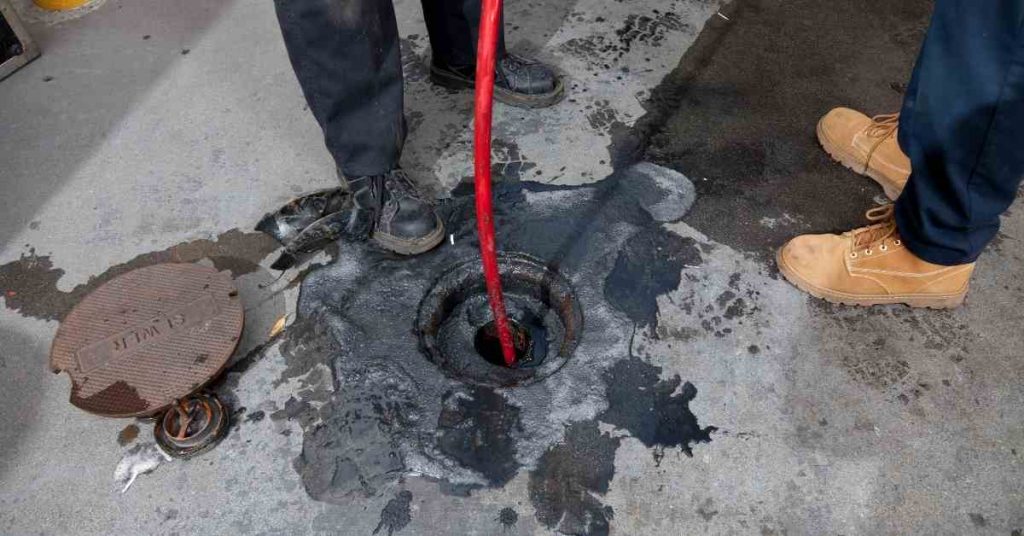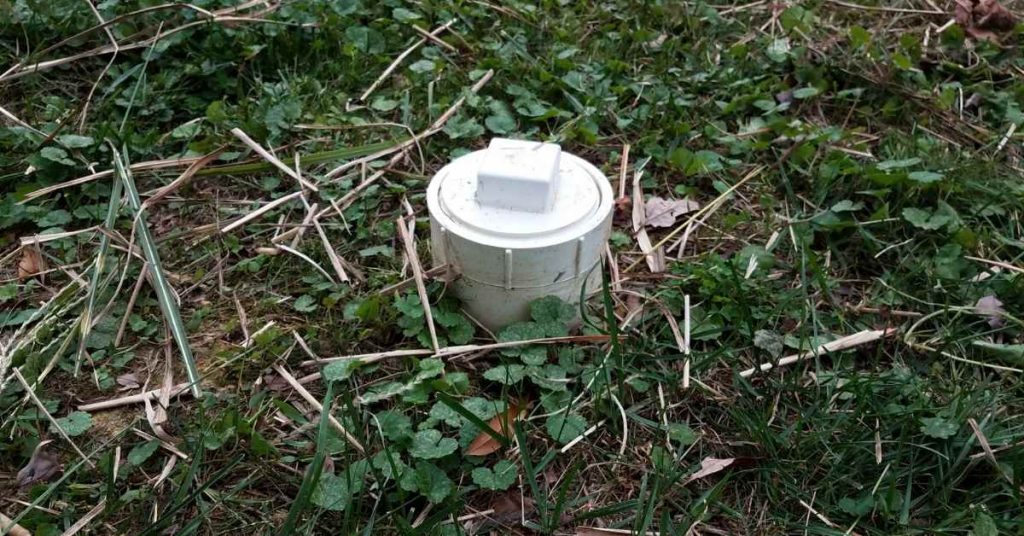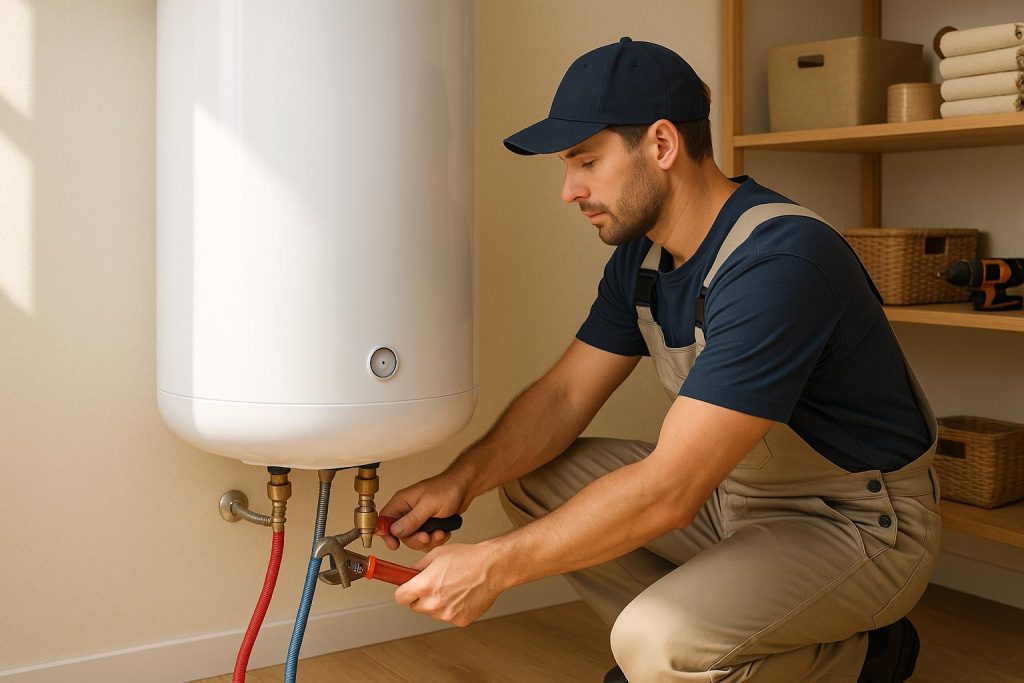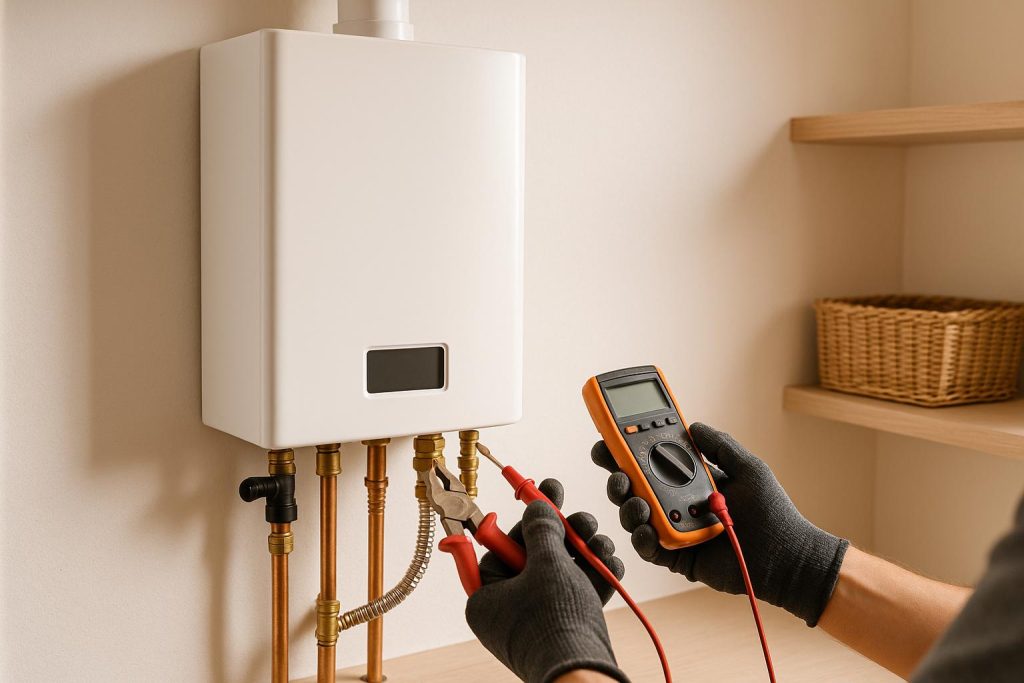
Hydro jetting, snaking, and rodding are three common methods used to clear clogged drains and sewer lines. Each method has its pros and cons. Here’s a summary comparing the pros and cons of hydro jetting against snaking and rodding:
Hydro Jetting
Hydro jetting is a high-pressure plumbing and drain cleaning technique used to clear clogs, blockages, and debris from pipes and sewer lines. It involves the use of a specialized machine that pressurizes water and propels it through a nozzle into the plumbing system.
The high-pressure water stream effectively breaks up and flushes away obstructions, including grease, sludge, tree roots, mineral deposits, and other debris, from the inside of pipes.
Pros
- Effective Cleaning: Hydro jetting uses high-pressure water streams to thoroughly clean and clear blockages. It can remove grease, debris, tree roots, and mineral deposits, leaving pipes almost like new.
- Versatile: Hydro jetting is suitable for various types of pipes, including PVC, clay, and cast iron, and can clear both small and large-diameter pipes.
- Long-Lasting Results: Since hydro jetting cleans the entire pipe’s inner surface, it can provide longer-lasting results and reduce the risk of future clogs.
- Environmentally Friendly: Hydro jetting typically doesn’t require harsh chemicals, making it an environmentally friendly option.
Cons
- Cost: Hydro jetting equipment is expensive, and professional services can be relatively costly compared to other methods.
- Professional Required: Hydro jetting should be performed by trained professionals due to the high-pressure equipment involved.
Snaking
Pros
- Affordability: Snaking is generally a more affordable option for clearing simple clogs and blockages.
- Quick Fix: Snaking can often provide a quick solution for minor clogs, allowing water to flow freely again.
- DIY Option: Basic drain snakes are available for home use, making it possible for homeowners to attempt unclogging themselves.
Cons
- Limited Cleaning: Snaking primarily focuses on breaking up and removing obstructions. It may not completely clear away debris on the pipe’s walls, potentially leading to future clogs.
- Not Suitable for All Clogs: Snaking may not be effective for severe or stubborn clogs, tree root infiltrations, or mineral deposits.
Rodding
Pros
- Effective for Roots: Rodding can be effective for cutting through tree roots that have infiltrated pipes.
- Availability: Rodding equipment is widely available, and some basic models can be used for DIY purposes.
Cons
- Limited Cleaning: Similar to snaking, rodding primarily focuses on breaking up and removing blockages but may not thoroughly clean the entire pipe.
- Risk of Pipe Damage: If not used carefully, rodding can potentially damage pipes, especially older or fragile ones.
- Temporary Solution: Rodding may provide a temporary fix for clogs caused by tree roots, as roots can regrow over time.
The average cost of hydro jetting a sewer line is $300 to $600. The cost can however be as low as $250 or as high as $1000 depending on the severity of the clog, how long it takes, where you live among other factors.
How Hydro Jetting is Done

Hydro jetting equipment mainly comprises of 3 main parts:
- Nozzle
- High-pressure hose
- Pumping unit
The nozzle is attached to the high-pressure hose on one end while the other end of the hose is connected to the pumping machine.
Before the technician can start to hydro jet, they will first inspect the sewer line using a sewer inspection camera. The camera is connected to a cable while a monitor on the surface shows real-time images of the sewer line as well as the depth of the camera.
As such, it is easy for the technician to understand the sections of the sewer line where there is a clog or tree root infestation. They are also able to tell the structural integrity of the sewer line.
If the sewer line is collapsed, no amount of hydro jetting will fix it. They can also recommend the homeowner if the sewer line will need to be relined, especially old cast-iron pipes.
Both the sewer inspection camera and the hydro jet will access the sewer line through the sewer cleanout. A sewer cleanout is a pipe sticking a few inches from the ground around your house.

Sewer cleanouts are elbowed to the sewer line and in some houses they are located inside the house, either in the basement or crawlspace. They usually have a cap which a square nut at the top.
In houses which do not have a sewer cleanout, the technician can access the sewer line through the plumbing vent at the top of the house or through the toilet drain. They will however need to first pull out the toilet. This will increase the overall cost of the procedure.
With the help of the camera, the technician will place the nozzle inside the problematic area of the sewer line and start the pumping machine. Water at pressures of up to 5000 pounds per square inch (psi) will shoot out through the nozzle and obliterate the clog.
At the end of the procedure, the technician will run the camera again just to be sure that the sewer line is fully opened.
The Pros and Cons of Hydro Jetting
There are many advantages of hydro jetting your sewer line compared to other drain cleaning procedures but there are also a few limitations. Let us start with the advantages.
Cons
The following are the advantages of hydro jetting:
1. Hydro Jetting is Non-Invasive
In the past, if you had a clogged sewer line that won’t unclog, you had to bring a crew to dig it out. That means a deep trench in your yard and even when it is covered, you will need to start landscaping all over again.
That does not happen with hydro jetting. The technician will only need to gain access to the sewer line via the cleanout and in 2 hours there will be no sign that you had a problematic sewer line.
2. Hydro Jetting Actually Cleans the Pipe
When you have a clogged sewer line, it means wastewater cannot flow out of the house. For most homeowners, all they want is for the water to drain out regardless of which method used.
That is why some people will snake, rod or even try to clear the drain using chemical drain openers. Hydro jetting does more than just clear a clog.
A drain snake for instance will just drill a hole through the clog and as soon as the sewer line can drain most homeowners will be happy. On the other hand, hydro jetting will clean the entire bore of the sewer pipe, remove scales, breaking down the entire clog, removing tree roots and flushing everything down the drain.
3. Hydro Jetting is Safe for Pipes
As I mentioned earlier, hydro jetting is very safe. The pipes are first inspected if they can handle it so you can be sure that they will not collapse during hydro jetting.
On the other hand, a plumber snake can easily punch a hole through a pipe especially when snaking is being done as a DIY. Chemical drain cleaners on the other hand can badly damage your pipes as I explain in this post.
4. Hydro Jetting is Eco-Friendly
In hydro jetting the only waste is the water used to break down the clog. Needless to say, water cannot harm the environment in any way.
That can however not be said about chemical drain cleaners, some of which contain strong acids like sulfuric acid. The chemicals find their way into rivers and lakes where they pollute the water or even leach to the ground water and therefore contaminate it.
5. Hydro Jetting is Worth It
As I have mentioned, hydro jetting cleans the entire bore of the pipe thereby restoring it to its original internal diameter. As such, it will take long before another clog can develop inside the pipe.
A drain snake will clean the pipe in accordance with the size of the head attachment. It is therefore possible that a snake will only remove part of the clog and not the whole of it meaning clogs are more likely to recur.
Cons
So what are the disadvantages of hydro jetting? Here are the main ones:
1. Not Applicable to Frail Pipes
As I have already mentioned, if a sewer inspection report indicates that your sewer line cannot withstand hydro jetting, you will need to explore others ways to clean it.
Sewer pipes last for 50 to 100 years. If your sewer pipes are old and are likely to collapse during hydro jetting, snaking or rodding could be the only alternatives.
2. Hydro Jetting is Only Done by Pros
Unlike snaking which can be done by just about anyone, hydro jetting is and should be done by a trained professional. 5000 psi of pressure can injure someone or destroy property and that is why only a licensed plumber should do it.
Apart from that, you will need a special camera to inspect the sewer line and not many people have those cameras at home. The cost of buying the cameras and renting the hydro jetting equipment is also high and you are better off hiring a plumber.
3. Hydro Jetting Uses a Lot of Water
Apart from the cost of the hydro jetting procedure, your water bill for the month will considerably be high. This procedure is quite water-thirsty.
With a consumption of 20 gallons of water per minute for a process which can take 60 to 90 minutes, you are looking at using 1200 to 1800 gallons of water.
Hydro Jetting vs Snaking

A drain snake, also known as a plumber’s snake is a flexible cable with a head attachment which spins and cuts through the clog or tree roots.
There are manual drain snakes where the cable and head are driven in the sewer line by cranking a handle and there are long motorized augers. Such are the ones used by professional plumbers.
The good thing with electric drain snake is that you can attach heads of different sizes, starting with a small one gradually increasing till you get to the one matching the size of the sewer pipe.
The heads have spinning blades which cut through the clog and grind tree roots in the pipe. Although drain snakes can be rented and used as DIY, they can injure the person using them and sometimes even damage the pipes.
As I mentioned before, snaking will clear drain clogs and roots but will not clear the pipe. Even after unclogging the sewer line, you will be left with a scaled sewer pipe.
In instances where hydro jetting is not applicable like old frail pipes, snaking will come in handy. Do not however snake a sewer pipe relined using epoxy liners to avoid damaging it.
Hydro Jetting vs Sewer Rodding
Most people confuse sewer rodding and snaking. The concept is the same but there are a few differences.
In rodding different rods of flexible cables are connected together and pushed down the sewer line to unclog it. A head attachment is connected to the first rod and then subsequent rods are connected to it until you get to the clog.
To clear the clog, you hammer it using the head attachment by pulling and pushing down the cables.
In modern plumbing, plumbers have embraced power rodding. In power rodding, a thin highly-flexible cable connected to an electric motor and with an attachment with sharp blades is pushed in the sewer line and spun very fast.
The head attachment is the exact size of the sewer line therefore it is not only able to clear the clog but also cut through the tree roots and also remove the scale build-up.
Both hydro jetting and power rodding are very effective methods of cleaning the drain and you should ask a plumber to recommend the most appropriate one for your sewer line.
Wrap Up
And basically that is everything you need to know about hydro jetting. I hope you found this guide useful.





